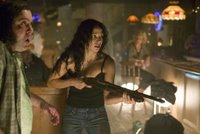 I know a lot of people that swear by the comedy of Broken Lizard. And man, I tried watching SUPER TROOPERS. Saw it twice so far, and while I think it's funny, I wasn't ready to proclaim them the next coming or anything. In this I know I differ with a lot of people.
I know a lot of people that swear by the comedy of Broken Lizard. And man, I tried watching SUPER TROOPERS. Saw it twice so far, and while I think it's funny, I wasn't ready to proclaim them the next coming or anything. In this I know I differ with a lot of people.I also know I'm going to differ with those same people for another reason: I loved CLUB DREAD, and find it in leaps and bounds the better film.
I think the reason it works (certainly much better than FEAST) is because, instead of taking a horror film and trying to make it funny, they took a comedy and made it horrific. And by "horrific" I mean "as scary as your typical FRIDAY THE 13TH film" which was the point, even nodding to the film in question in a hilarious boat scene.
 Vacationers travelling to Pleasure Island are coming for two things: getting drunk and getting laid. And that exactly what Coconut Pete (Bill Paxton) and his staff are there to provide - it's Heaven if Heaven was run by the dude who puts out those Girls Gone Wild videos. Unfortunately, the wacky staff (played by the Broken Lizard troop) pissed somebody off with their antics, because now they're slowly being murdered one by one. Is it the crazy obsessive gymnast? The put-upon nephew of Coconut Pete? Or the new masseuse, fresh off the boat and with secrets of his own?
Vacationers travelling to Pleasure Island are coming for two things: getting drunk and getting laid. And that exactly what Coconut Pete (Bill Paxton) and his staff are there to provide - it's Heaven if Heaven was run by the dude who puts out those Girls Gone Wild videos. Unfortunately, the wacky staff (played by the Broken Lizard troop) pissed somebody off with their antics, because now they're slowly being murdered one by one. Is it the crazy obsessive gymnast? The put-upon nephew of Coconut Pete? Or the new masseuse, fresh off the boat and with secrets of his own?The movie benefits from a few things - as always the chemistry between the cast is great. Roles are reversed from the earlier SUPER TROOPERS, with director Jay Chandrasekhar this time playing the prick-ish Putnam, and scene stealer Kevin Heffernan taking the heroic lead. The majority of the comedy is character-driven, playing to everyone's advantage. And the troop brings enough great lines so that the rest of cast isn't left behind as window dressing, though they of course save the best for themselves. I will forever attempt to use the line "Who else knew he was uncircumcised, and smelled of oranges?"
As for the scares, they're firmly rooted in the slasher pics of the early 80's, but instead of playing the horror off for laughs, Chandrasekhar wisely plays them straight most of the time. The blood and gore is realistic and frightening, even when it's spurting from a man dressed as a pear:
 Please, someone put together a version of Pac-Man like this NOW, please!
Please, someone put together a version of Pac-Man like this NOW, please!You really have no idea who the killer is, and there's no reason to try and guess in CLUB DREAD. The focus here is purely on the laughs; any screams or jumps are free of charge. Perfectly fun movie, and I'm convinced I have to check out SUPER TROOPERS again.






















